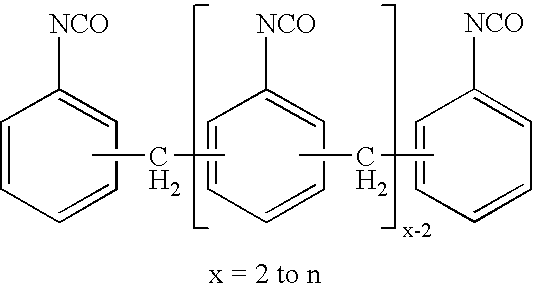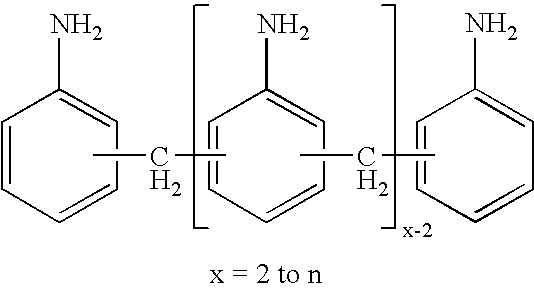Production of di- and polyisocyanates of the diphenylmethane series with defined acidity
a technology of diphenylmethane and polyisocyanate, which is applied in the preparation of isocyanic acid derivatives, isocyanic acid derivatives, organic chemistry, etc., can solve the problems of undesirable deviations in the reaction behavior of mdi, unavoidable variations in acid content, and deviations from desired acidity. , to achieve the effect of accelerating the reaction of isocyanate groups, avoiding undesirable deviations, and avoiding problems
- Summary
- Abstract
- Description
- Claims
- Application Information
AI Technical Summary
Benefits of technology
Problems solved by technology
Method used
Image
Examples
example 1
Adjustment of the Acidity of a Polymeric MDI (PMDI)
[0049] 11 batches of a polymeric MDI were produced by steps a) through c) of the process described above in accordance with the present invention. The 11 batches had a content of 3-ring MDI and multi-ring MDI of 46 to 49 wt. %.
[0050] In step d), the acidity of the individual batches was determined analytically. This determination of the acidity occurred by the following method: [0051] About 6 g of the MDI polymer sample were weighed to an accuracy of at least 0.01 g into a 250 ml beaker. 60 ml of chlorobenzene were then added and the MDI sample was dissolved in the added quantity of chlorobenzene. Then, 100 ml of methanol were added to the solution, the beaker was covered and the mixture was stirred for 30 min at ambient temperature using a magnetic stirrer. Finally, the mixture was titrated acidimetrically, using a methanolic potassium hydroxide standard solution with a molar concentration of approx. 0.01 mol / l, with a potentiome...
example 2
Adjustment of the Hydrolysable Chlorine Content for Monomeric MDI
[0054] For monomeric MDI, the acidity of the MDI was determined as the hydrolysable chlorine value.
[0055] 85 batches of a monomeric MDI were produced by steps a) through c) of the process described above in accordance with the present invention. The 85 batches had a 2-ring MDI content of >98.2 wt. %. The individual 2-ring MDI isomers were contained therein in the following quantities: 4,4′-MDI (≧98.0%), 2,4′-MDI (≦2.0%) and 2,2′-MDI (≦0.3%), based on the sum (i.e. total weight) of the 2-ring MDI isomers.
[0056] In step d), the hydrolysable chlorine value was determined. This determination of the hydrolysable chlorine value occurred by the following method: [0057] About 10 g of the MDI monomer sample were weighed into a 500 ml Erlenmeyer flask. The MDI monomer was then melted in a boiling water bath and dissolved in 40 ml of chlorobenzene. Then, 100 ml of propanol-(2) were added, the Erlenmeyer flask was covered and t...
PUM
| Property | Measurement | Unit |
|---|---|---|
| Fraction | aaaaa | aaaaa |
| Chemically inert | aaaaa | aaaaa |
| Acidity | aaaaa | aaaaa |
Abstract
Description
Claims
Application Information
 Login to View More
Login to View More - R&D
- Intellectual Property
- Life Sciences
- Materials
- Tech Scout
- Unparalleled Data Quality
- Higher Quality Content
- 60% Fewer Hallucinations
Browse by: Latest US Patents, China's latest patents, Technical Efficacy Thesaurus, Application Domain, Technology Topic, Popular Technical Reports.
© 2025 PatSnap. All rights reserved.Legal|Privacy policy|Modern Slavery Act Transparency Statement|Sitemap|About US| Contact US: help@patsnap.com


